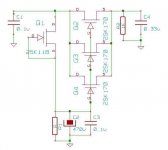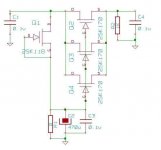Joshua_G closer, but use an N ch fet instead of the 103. You don't really need the following the 170, as the 170 is quieter than the IC you are using.
PMA said:Sampling theorem requires sampled signal to be frequency limited at Fs/2, there must be no spectral component above Fs/2. The music is not limited to 22kHz, signal is brickwalled, reconstruction is right for the wrong (frequency cutted) signal; so in fact John is right.
What you say is right, what John said about pre-shoot is wrong.
Unless you both mean the same thing, in which case I apologize for the misconception.
I could be wrong about the terminology. I am not a digital engineer, BUT if any part of the signal precedes the main signal in an impulse, then I think that the ear can be effected by that artifact.
SY said:(...) the system could have been made much more phase correct without the need for all the fancy upsampling bandaids (which only take care of one end of things) (...)
By "one end of things" do you mean "only at the D/A end"? Modern A/Ds use upsampling as well. For these, the analog anti-aliasing filter only needs to have high attenuation at and above Nfs/2 (rather than fs/2), where fs is 44.1 kHz and N is the oversampling ratio. This allows for more gradual analog anti-aliasing filters having more linear phase from DC to fs/2. Then the brickwall cutoff at fs/2 is accomplished in the digital domain with a linear phase FIR filter when the stream is downsampled back to fs.
Yes, but that was not the case for the first decade or so. The Apogee filters were an early bandaid. But if the filtration on both ends were part of the standard, the data could have been easily precorrected to give a flat phase response. That would have saved a lot of engineers' time.
That's an interesting thought. I hadn't considered that idea.
I think Sony and Philips pretty much screwed the pooch on the CD standard. It's amazing that (at least some) modern implementations sound as good as they do.
I think Sony and Philips pretty much screwed the pooch on the CD standard. It's amazing that (at least some) modern implementations sound as good as they do.
If Sony and Phillips had NOT driven the standard I would not have had the enjoyment of CD's in my car for the last 10 years and who knows what mix of ridiculously expensive equipment and media I might have needed for the home. Thank goodness these commercial organisations exist to provide us with commercially viable and sonically adequate products. If we had only the type of equipment that half the contributors to this thread seems to want then we would be back in the dark ages techincally and under the spell of middle ages witchcraft and religion in general.
John, can you name a commercial outfit that DOES NOT press for standards that serve the organisation commercially? Where is the proper examination that prevents prejudice ?
John, can you name a commercial outfit that DOES NOT press for standards that serve the organisation commercially? Where is the proper examination that prevents prejudice ?
And I still can't enjoy CD in my car, because I find it annoying. Go figure. (Maybe, if people tried harder to make better sounding equipment, this would not be so?)

john curl said:Joshua_G closer, but use an N ch fet instead of the 103. You don't really need the following the 170, as the 170 is quieter than the IC you are using.
Thank you, John.
How about this one?
Attachments
Really good, but I would recommend 0.1uf polystyrene or polypropylene cap for C4. This can be more important than you would normally think.
alansawyer said:
Thank goodness these commercial organisations exist to provide us with commercially viable and sonically adequate products.
How much the results are adequate is the issue. Definitely, the results are adequate to many people, not so much to audiophiles.
john curl said:Really good, but I would recommend 0.1uf polystyrene or polypropylene cap for C4. This can be more important than you would normally think.
Done:
Attachments
44.1KHz was a complete Sony artifact. Even Phillips used 50KHz when I visited them in 1974. We used 50 KHz in 1968 at Ampex. Why?
john curl said:R2 is also unnecessary, unless you are putting it there as a dummy load.
Done:
Attachments
john curl said:44.1KHz was a complete Sony artifact. Even Phillips used 50KHz when I visited them in 1974. We used 50 KHz in 1968 at Ampex. Why?
The analog anti-aliasing filter.
syn08 said:
Which leaves my last question open: how is this thing built to stay stable with 8xJFET at the input? The only thing that I can think of is ferrite beads on the gates, but somehow I don't believe John went this path.
WRT stability, are you running open loop or closed loop? Try some
R's in the drains. Also try separate load R's on sources, obviously they
have to be small.
T
I don't use 8 devices, I use 4 jumbo devices and only 2 of these directly in parallel. I use both N and P and isolate with a center tapped 10 ohm wire wound pot with the wiper to ground.
john curl said:I don't use 8 devices, I use 4 jumbo devices and only 2 of these directly in parallel. I use both N and P and isolate with a center tapped 10 ohm wire wound pot with the wiper to ground.
From your post http://www.diyaudio.com/forums/showthread.php?postid=1699998#post1699998
john curl said:
It used 4 paralleled Toshiba devices, (equivalent to 8 2sk170 fets) operating at 12-15ma ea, pre-selected for less than 1.3nV/rt Hz at 10Hz.
[...]
I have 8 paralleled 170's selected for very low 10Hz noise with a series 2.5 ohm resistance.
Care to explain the discrepancies? Are you using 2SK389V and 2SJ109V? This would make 2 (for V class) x 2 (for differential mode gain) x 2 (for P/N legs) = 8 x 2SK170BL
Then indeed no wonder you had no stability problems and it's also true it would be very hard to clone your design's performance today. Which doesn't mean I'm not going to do it, most likely with BF862 and SMD ferrites 😀 Stay tuned!
- Status
- Not open for further replies.
- Home
- Amplifiers
- Solid State
- John Curl's Blowtorch preamplifier



